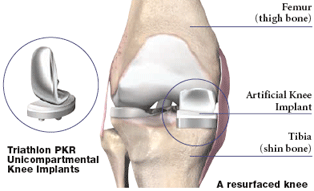phone | 702-228-7355

phone | 702-228-7355

 MIS Partial Knee Resurfacing (PKR)
MIS Partial Knee Resurfacing (PKR)
Partial Knee Resurfacing (PKR) is a minimally invasive procedure for relieving arthritic knee pain and disability. With PKR, only the damaged surface of the knee joint is resurfaced, potentially minimizing trauma to healthy bone and tissue. PKR implants were developed with patient needs in mind. Because the PKR implants are so much smaller than total knee implants, the surgical incision can be smaller as well.
Potential Advantages
Because fewer muscles and tendons are disturbed with the minimally invasive techniques, their reconstruction is often more natural, wound closure is easier, and recovery may be faster.1 Clinical studies have shown that the midvastus surgical approach used in the MIS technique results in less pain (at both 8 days and 6 weeks after surgery) and quicker restoration of muscle control and strength.2 It may take several months to recover from the large incision and muscle disruption that accompanies the standard approach.1
Risks Associated with Minimally Invasive Surgery
The MIS Knee Joint Replacement technique is less invasive than conventional TKR, but it is still a major surgery. It takes little additional time to complete and may result in advantages for the patient.
As with any major surgical procedure, patients who undergo total joint replacement are at risk for certain complications, the vast majority of which can be successfully avoided or treated. In fact, the complication rate following joint replacement surgery is very low. Serious complications, such as joint infection, occur in less than 2% of patients.3 (Besides infection, possible complications include blood clots, lung congestion, or pneumonia.) The risks that are normally encountered in conventional knee joint replacement remain.
Stryker Corporation or its divisions or other corporate affiliated entities own, use or have applied for the following trademarks or service marks: Stryker and Triathlon. All other trademarks are trademarks of their respective owners or holders.